-
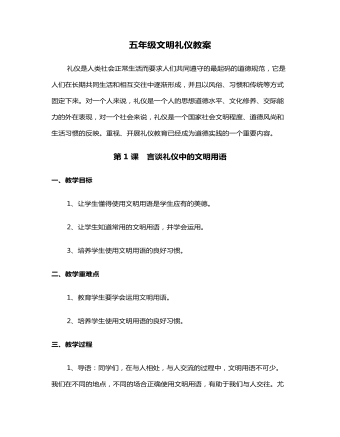
五年级文明礼仪教案
1、导语:同学们,在与人相处,与人交流的过程中,文明用语不可少。我们在不同的地点,不同的场合正确使用文明用语,有助于我们与人交往。尤其是对于我们学生来说,如果经常使用文明用语,那么人人都会喜欢我们,夸奖我们。 2、讲故事:一个年轻人去张村,可他不认识去张村的路。半路上遇见一位老人,年轻人喊道“喂,老头儿,这里离张村有多远?”老头脱口而出:“无礼!”年轻人足足走了五里路,一直没有看见有叫张村的地方。年轻人停下来想了又想,似乎悟出了什么。年轻人的行为给自己带来了什么结果?(小结)什么是礼貌,它与尊重的关系。 你想做个懂礼貌的孩子吗?要想懂礼貌必须先知道什么? 3、学生说出常用的文明语言及使用的场合和对象。(小组讨论,选代表发言) 4、考察情况,即兴表演。同学们说得都很不错,现在我们就来比一比,哪一组是文明礼貌大组。必须认真听老师提出的问题,然后派人表演,表演合格就能领到通行证,得到通行证最多的组就是文明礼貌大组。
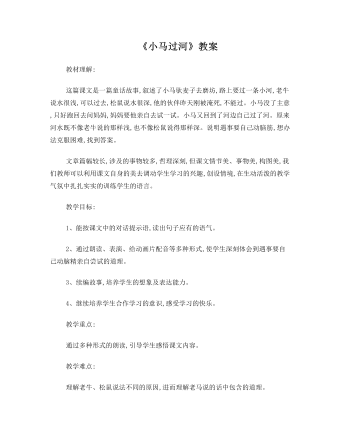
二年级语文小马过河教案
这篇课文是一篇童话故事,叙述了小马驮麦子去磨坊,路上要过一条小河,老牛说水很浅,可以过去,松鼠说水很深,他的伙伴昨天刚被淹死,不能过。小马没了主意,只好跑回去问妈妈,妈妈要他亲自去试一试。小马又回到了河边自己过了河。原来河水既不像老牛说的那样浅,也不像松鼠说得那样深。说明遇事要自己动脑筋,想办法克服困难,找到答案。文章篇幅较长,涉及的事物较多,哲理深刻,但课文情节美、事物美,构图美,我们教师可以利用课文自身的美去调动学生学习的兴趣,创设情境,在生动活泼的教学气氛中扎扎实实的训练学生的语言。
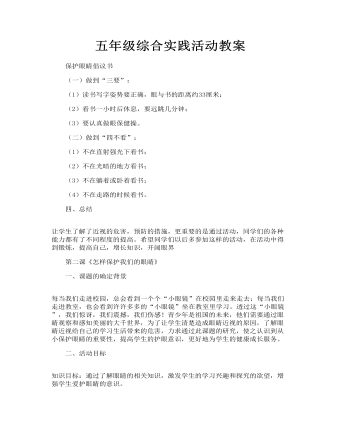
五年级综合实践活动教案
第二课《怎样保护我们的眼睛》 一、课题的确定背景 每当我们走进校园,总会看到一个个“小眼镜”在校园里走来走去;每当我们走进教室,也会看到许许多多的“小眼镜”坐在教室里学习。透过这“小眼镜”,我们惊讶,我们震撼,我们伤感!青少年是祖国的未来,他们需要通过眼睛观察和感知美丽的大千世界,为了让学生清楚造成眼睛近视的原因,了解眼睛近视给自己的学习生活带来的危害,力求通过此课题的研究,使之认识到从小保护眼睛的重要性,提高学生的护眼意识,更好地为学生的健康成长服务。

人教版新目标初中英语八年级上册Can you come to my party教案3篇
Step 3 (3b)First, tell the students when we talk about our future plans, we often use: I’m+verb+ing When we talk about what we must do, we use have to. Ask the students to fill in the blanks in 3b. The answers are: shopping, go to see, a test, I’m going, my family. Step 4 (3c)Let the students write an e-mail message to a friend. Say why you can’t visit next. Before the exercise, ask the students to give some possible answers and write them on the blackboard. So the students will feel easy to finish the writing exercise. After they finish it, Let them to correct it in groups first. Each group chooses theirs best one to read in front of the whole class. Step 5 ( planning a party )First read the conversation in the box together. Then ask the students to turn to page 88.Write down everything you have to do next week. Write in all the things you have to do . Ask the students to look at the list. Ask them “What day are you free?” This is when you can have your party. Step 6 (Self check 1 )Let the students to fill in the blanks with the words given. Change the forms of the words if possible. Then make their own sentences. The answers are: visit, playing, have to, study, comeStep 7 (Self check 2)Imagine you are Marie. Read the information and look at your schedule. Write replies to the invitation.

人教版新目标初中英语八年级上册How do you make a banana milk shake教案2篇
1. First, ... then, ... next, ... finally, ...首先,……然后,……接着,……最后,……这是英语中表达做某事的步骤的一种说法。如果步骤较多,还可以说:first-next-after that-later on-finally/at last通常你会听到说英语国家的人在说 first, next, then, finally 和后面的内容时,他们会做一些停顿。这样就能提前告诉听者接下来讲的是一系列的步骤。这一点在朗读和听力中应特别注意。2. how many, how much均为疑问词,同是“多少”,但用法不同。请看:how many修饰可数名词复数,how much修饰不可数名词。但在用法上,同学们常犯如下错误:1) [误] How many are there bananas on the table?[正] How many bananas are there on the table?[析] how many, how much 中的many,much是形容词,常修饰名词作定语,故后面跟名词。2) [误]How much tea are there on the table?[正]How much tea is there on the table?[析] how much修饰不可数名词时,谓语动词用单数。how many与how much的区别可简记为:前how many:问“多少”,复数名词后面跑;how much问“多少”,不可数名词单数好。前者答语用基数词,后者答语用数量关系。

人教版新目标初中英语八年级上册How was your school trip教案2篇
“Go for it!” is based on “Task-Based Language Teaching”. It adheres to “The authenticity principle”, “The form-function principle”, “The task dependency principle” and “The principle of learning by doing”. These principles all accord with the demands of curriculum focus.In and of Grade Seven (II), “Go for it!”, students have learned “The Simple Past Tense”. And it appears again in of Grade Eight (I). teaches students more about how to talk about events in the past. In addition, it gives affirmative and negative statements in the past tense, such as the sentence patterns “Did you see …?” “Were there …?” “Did you go …?” As the first part of Unit 8, Section A opens with a picture presenting the last school trip in the aquarium and continues with several step-by-step practice activities, which are all good for students to master “The Simple Past Tense”. Doing well in Section A will help students integrate the new target language with that in Section B. Thus, they can describe the events in the past freely and foster their own ability of reflecting and practicing. II. Teaching ObjectivesTeaching objective is the beginning and aim of teaching activities. According to the overall goal of the English elementary course--- improve students' synthetic ability of language application, which should be based on the development of students’ “Language knowledge”, “Language skills”, “Character building”, “Learning strategies” and “Cross-cultural awareness”. The teaching objectives are described as follows(I). Knowledge objectivesi. Master the simple past tense of regular and irregular verbsii. Recite the new words and expressions about the last school trip in the aquarium, including their pronunciation and intonation

人教版新目标初中英语八年级上册Could you please clean your room教案3篇
一、 教学内容Section A 1a----1c二、 教学目标1.学习词汇do the dishes, make the bed, take out the trash, fold the clothes, do the laundry, sweep the floor, clean the living room.2.句型 Could you please clean your room? Yes, sure.三、 教学准备 学生预习本单元所有的词汇多媒体课件 活动表 奖品四、 教学过程Pre-task1. Warming upEnjoy ourselves. Watch cartoon Cinderella. 看动画片段《灰姑娘》导如入本课话题和新词汇“chores”美丽善良的鬼姑娘因继母的嫉妒,每天得做所有的家务。片段的主题使学生联想到本课的话题。2. learn new words and phrasesLook! What is she / he dong? 看图学习动词词组do chores, do the dishes, make the bed, take out the trash, fold the clothes, do the laundry, clean the living room.3. Guessing game.What is she doing ? 4. Pair work. 1a, Do you do these things at home? Write “Y” for “yes” and “N” for “no”.5. Listening . 1b , Peter’s chores or Mom’s chores?理解目标语Could you please clean your room? Yes, sure.Write “M” for Mom’s chores, “P” for Peter’s chores in the chart.6. PairworkLook at the picture,Ask your partner to do the chores that you see. 7. Interview Who is the most able at home? 1) What chores do you do at home? How often do you do the chores? Work in four, interview each of the students in the group, fill in the chart.

人教版新目标初中英语八年级上册How do you get to school教案2篇
Step Ⅶ Role play ( Work on 1b)1. First ask two students to read the dialogue to the class.Sa: How do you get to school?Sb: Well, I ride my bike to the subway station. Then I take the subway.2. Now work with a partner.Suppose you use two kinds of transportation to get to school \Hangzhou\Beijing... (bus, train, subway, walking, bike, etc.) Tell how you get there. You may use the phrases in 1a.3. Then ask different pairs of students to present their conversations to the class.Step ⅧListening1. Work on 2a(1) First ask students to read the list of information that Thomas wants to know.…where Nina lives.…how far from school she lives.…how long it takes to get to school.…how she gets to school.…what she thinks of the transportation.(2) Tell students what transportation and bus stop mean.bus stop 汽车站 transportation n. 运送;运输Then tell students we'll hear a recording. Please put a checkmark in front of each thing that Thomas wants to know.(3) Now play the recording for students.( Have students pay attention to the sample answer.) (4) Then correct the answers.

人教版新目标初中英语八年级上册What are you doing for vacation教案2篇
Teaching goals : 1. Words & phrases: babysit ,get back , fishing , rent , think about , decide(on) , tourist etc. 2. How to talk about future plans . 3. 现在进行时表示将来计划或行动. 4. 特殊疑问句(where , when , how long引导) Important and difficult points : Drills :What are you doing for vacation ? I’m watching TV . When are you going ? I’m going … . How long are you staying ? We’re staying for five days . Teaching aids : cards and a tape ,a large wall calendar . Period 1 Teaching procedures : Step 1Leading in1. Free talk . 2. Put up the wall calendar . T: I’m staying home on Saturday (pointing to next Saturday ).Ss repeat . Ss: I’m staying home on Saturday . T: OK. Today we’ll learn how to talk about future plans. Step 2Pre-task SB Page 13 , 1a . 1. Look at the picture carefully and tell what you see in the picture . 2. Write the activities from the pictures in the box and add some more . 3. Practice reading . Step 3While-task1. Using the activities we write in 1a to make conversations .For example :What are you doing for vacation ? I’m visiting my uncle . 2. Pairwork .Practice in pairs . 3. 用第三人称练习对话.

人教版新目标初中英语八年级上册I’m going to be a basketball player教案3篇
教学目标1.知识目标:(1)学习What are you going to be when you grow up?/How are you going to do that?句式。(2)学会用英语描述有关职业的表达法。2.能力目标:(1)能够谈论为实现理想所做出的打算和安排。(2)能够谈论未来自己与他人理想的职业及原因。(3)能用英语描述课余时间的活动安排,最终具备表达综合信息的能力。3.情感目标:新学期到来之际,让他们在学习、体育、饮食、特长、读书等方面制定计划,教育学生合理安排自己的课外生活,思考自己的理想职业及适合自己的职业。教学重点、难点本单元的重点为“be going to”表将来,want to be, what,where, when,how引导的特殊疑问句。难点是语言目标的实现。教材分析本单元以I am going to be a basketball player为话题,共设计了三部分的内容:一、Section A该部分有4个模块。第一模块围绕Do you think these jobs are interesting?这一话题展开思维(1a)、听力(1b)、口语(1c)训练;

人教版新目标初中英语八年级上册I’m more outgoing than my sister教案2篇
1 交通工具的比较此活动为小组活动。学生通过讨论找出到达某一城市可乘坐的各种交通工具,并选择最佳出行方式。Teacher:We’re going to Shanghai. How many ways can we use to get there? Yes, there are four ways: by bus, by plane, by train, by ship. Please discuss how you are going to get there.操作建议:(1)学生以小组为单位展开活动,谈论本组所选择的交通工具。(2)各组选代表向全班汇报,阐述本组所选择的交通工具的利和弊。完成任务所需要的语言结构:We can go there by ship. It’s more comfortable and cheaper than any other transportation.We can go there by bus. It’s cheaper but it takes longer time.2 哪个城市更合适?此活动具有挑战性。假设中国要举行2014年世界杯足球赛,分别从历史,人文,天气等方面对各城市(北京,大连,上海,昆明)进行比较,选择最佳举办城市。T: Imagine China is holding the 2014 FIFA World Cup. Which city do you think is the best for the World Cup, Beijing, Dalian, Shanghai or Kunming? Let’s work in groups. If you choose Beijing, please join the Team Red. If you chose Dalian, please join the Team White. If you choose Shanghai, please join the Team Blue. If you choose Kunming, please join the Team Green. Please show us its advantages. Then let’s see which team will win.

人教版新目标初中英语八年级上册What’s the best radio station教案2篇
教学重点和难点:运用所掌握的语言描述,比较不同地点的特点。在练习中学习掌握英语比较级和最高级的用法。课前准备分配小组,每组五至六人。通过上网或翻阅报刊杂志等方法,确定旅游线路,做出基本的旅游计划。教学设计:本节课流程图 学法指导:1.由于这是一堂新课,在教学中应注意面向全体,发挥学生的主体性,引导学生积极参与,激发学生的求知欲和学习积极性,指导学生积极思维,主动获取知识,养成良好的学习方法。逐步学会独立解决问题。总之要尽可能调动学生的非智力因素促进智力因素的发展。教法选择:1.电化教学法2.课堂讨论法3.任务型教学法采用这些方法的目的是为了充分调动学生的学习积极性,使学生变被动学习为主动学习。通过电脑形象的演示,加强印象,提高兴趣,突破难点,提高教学效率,进而增大教学的容量和信息量。充分体现教师为主导,学生为主体的教学原则。

人教版新目标初中英语八年级上册What’s the matter教案2篇
She shouldn’t go to the party tonight.Step7. TaskT: You know, there are lots of problems in our life. If you are a doctor, please tell us how to solve the problem. I will divide you into 9 groups. Please work in groups. And then choose one of you to report your ideas.The following are the problems:I have a toothache.I am hungry. I have a sore throat.I am stressed out. I have a sore back.I am tired. I can’t sleep.I have a cold. I have a headache.Report: If you have a headache, you should go to bed early. You should see the doctor. You should eat some medicine. You shouldn’t wash your face with cold water.You shouldn’t sleep late.You shouldn’t swim.…..T encourages the students to give advice as much as possible.Homework:1. Chose one of the problems, and write down your advice2. Copy the new words这一步是用于热身的,同时也可以让他们复习一部分的表示人体部位的单词,扩充知识.学习语言的过程也是一个不断积累的过程,复习旧知识,增添新知识.通过小游戏,强化学生对Does she/he have…这个句子的运用能力.通过复习,自然的引到下面新知识的学习。充分利用表格,由句子到对话,再到文章,让学生循序渐进. 提高学生的综合语言运用能力,运用以前学过的知识来解决身边的问题.Period 5 (Section B 3a—3c, selfcheck)教学内容与分析:

人教部编版语文八年级上册“飞天”凌空——跳水姑娘吕伟夺魁记教案
中国女子跳水五位著名运动员“跳水女皇”高敏是我国首位奥运跳板跳水金牌获得者,自1986年夺得第一个国际比赛的冠军以来,一直到1992年退役,她包揽了其间包括世界杯、世锦赛和奥运会在内的所有国际比赛的70多个世界冠军。跳水界的传奇人物伏明霞年仅14岁就成了奥运史上最年轻的冠军,被载入吉尼斯世界纪录。同时,这位板台双冠王还是我国奥运史上首位三连冠运动员。“跳水皇后”郭晶晶于1993年进入国家跳水队,2011年正式退役。她共收获了包括世界杯、奥运会、世锦赛和亚运会等在内的31个世界冠军,是世锦赛史上唯一的五连冠得主。吴敏霞在1998年入选国家跳水队,一直被认为是郭晶晶之后的我国跳水队的又一位领军人物。2016年,她收获了个人的第五枚奥运金牌,与邹凯并列我国奥运史上夺金最多的运动员。
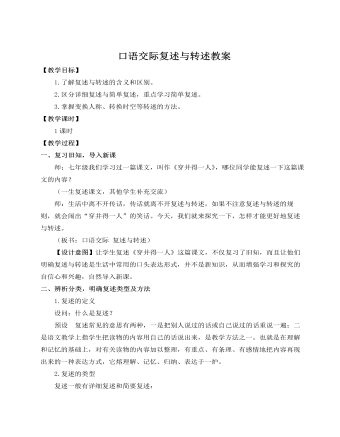
人教部编版语文八年级上册口语交际复述与转述教案
五、加工信息,学会表述师:请同学们阅读课本P122第三题,用自己的话告诉同学,什么是经典。课件出示:1.经典作品是那些你经常听人家说“我正在重读……”而不是“我正读……”的书。2.经典作品是这样一些书,它们对读过并喜爱它们的人构成一种宝贵的经验;但是对那些保留这个机会,等到享受它们的最佳状态来临时才阅读它们的人,它们也仍然是一种丰富的经验。3.一部经典作品是一本每次重读都好像初读那样带来发现的书。4.一部经典作品是一本即使我们初读也好像是在重温我们以前读过的东西的书。5.一部经典作品是一本从不会耗尽它要向读者说的一切东西的书。6.经典作品是这样一些书,我们越是道听途说,以为我们懂了,当我们实际读它们,我们就越是觉得它们独特、意想不到和新颖。
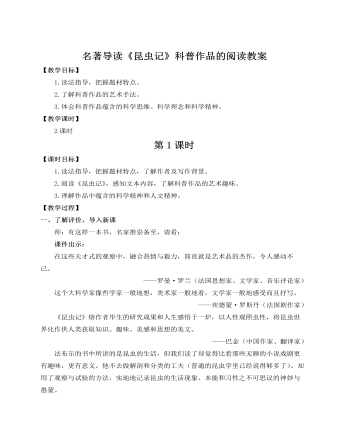
人教部编版语文八年级上册名著导读《昆虫记》 科普作品的阅读教案
整个的螳螂巢,大概可以分成三个部分。其中的一部分是由一种小片做成的,并且排列成双行,前后相互覆盖着,就好像屋顶上的瓦片一样。这种小片的边沿,有两行缺口,是用来做门路的。在小螳螂孵化的时候,就是从这个地方跑出来的。至于其他部分的墙壁,全都是不能穿过的。螳螂的卵在巢穴里面堆积成好几层。其中每一层,卵的头都是向着门口的。前面我已经提到过了,那道门有两行,分成左、右两边。所以,在这些幼虫中,有一半是从左边的门出来的,其余的则从右边的门出来。阅读感悟:作者介绍螳螂的巢时不仅对它们用的材料进行了说明,还对这两种材料做了进一步分析,而且对整个巢的构造做了详细的说明。这些正好体现出作者观察仔细、认真,乐于探究的精神。(2)法布尔科学实验的方法。综合上面两个片段,法布尔在研究昆虫时,经常采用的是观察法和实验法。课件出示:观察法可以直接用肉眼,也可以借助放大镜、显微镜等仪器,或利用照相机、录像机、摄像机等工具,有时还需要测量。
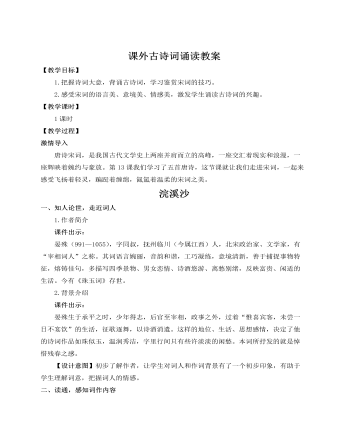
人教部编版语文八年级上册课外古诗词诵读教案
三、品读,感悟词人情怀1.品读“醉”意设问1:再次默读词作。想一想:这首词是围绕哪一个字来写的?从哪些地方可以看出来?预设 “醉”字。表现:沉醉不知归路;误入藕花深处。设问2:词人因何而“醉”?预设 因美酒和美景而“醉”。设问3:除了美景、美酒,还有什么会让李清照“醉”?预设 还有词人和自己的伙伴在一起的那种美好情谊,对年轻时那些美好生活的回忆,都让她深深陶醉。师小结:李清照的“醉”既是酒醉更是陶醉。其实不管“兴”也好,“记”也罢,“醉”也好,还是“误”也好,作者是“字字如金”。因为“兴”所以“醉”,因为“醉”所以“误”,因为“醉”,所以常常记得。2.品字悟情设问1:如何理解两个“争渡”表达出的情感?预设 两个“争渡”,表现了主人公急于从迷途中找寻出路的焦灼心情。正是由于“争渡”,所以又“惊起一滩鸥鹭”,把停栖在沙洲上的水鸟都吓飞了。至此,词戛然而止,言尽而意未尽,耐人寻味。

人教部编版语文八年级上册课外古诗词诵读教案
预设 反映了海边农村残破、荒凉的景象,表现了作者对下层人民的深切同情。【设计意图】“三分诗七分读”,学生反复诵读,与文本对话,感知诗歌的韵律和节奏,读出情味,为理解诗歌情感做铺垫。三、品读诗歌,含英咀华师:请同学们仔细品读这首诗,思考以下问题。设问1:曹植在海边看到了怎样的情景?预设 民不聊生,破败荒凉。其中,“寄身”三句,从生活环境、生活艰难和居住环境三个方面实写“边海民”的悲惨生活。海民寄身于“草野”,过着非人的生活,生吞活剥,巢息穴居,所以说“象禽兽”;他们不敢出来,怕被人发现、抓走,每天就钻在山林里边,所以说“行止依林阻”。一个“依”字把难民们的实际活动和恐惧心理都表现出来了。“狐兔翔我宇”一句通过对狐狸、兔子的描写,侧面描绘出海边贫民家庭条件的恶劣以及家园的破败。全诗正面描写与侧面烘托相结合,使海边贫民悲惨的生活图景跃然纸上。设问2:诗中哪一句最能体现作者的情感?
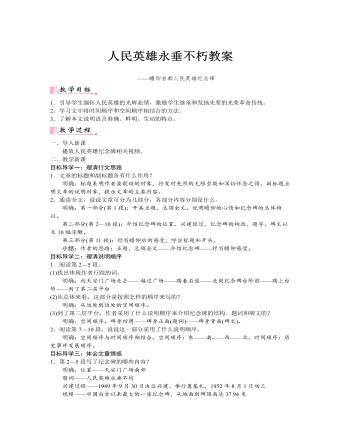
人教部编版语文八年级上册人民英雄永垂不朽教案
这篇文章的语言既有说明文语言准确、严密的特点,又有新闻特写鲜明、生动的特点,请和大家分享你最喜欢的语句,并说明理由。(学生发言)1.准确、严密示例:据地质学家化验证明,这些浮雕至少能耐800年到1000年之久。明确:“据地质学家化验证明”交代数据来源;“至少”对时间进行限定。2.鲜明、生动示例一:深夜,起义的新军和市民,摧毁了湖广总督府门前的大炮,正向总督府里冲去。总督府内熊熊的火焰冒向天空;总督府的牌子,被打断在阶前;撕碎了的清朝的龙旗,被践踏在地上。明确:“摧毁”“冲去”“冒”“打断”“撕碎”“践踏”一系列动词,准确生动地表现了起义者大无畏的革命气概,也揭示了清朝腐朽的本质。示例二:一群男女青年学生,举着“废除卖国密约”的旗帜,慷慨激昂地来到天安门前。梳着髻子、系着长裙的女学生,在向市民们散发传单。人群高处,一个男学生正在向围着他的群众演说。愤激的青年演说者,怒形于色的人群,使整个浮雕充满了痛恨卖国贼、激动人心的气氛。
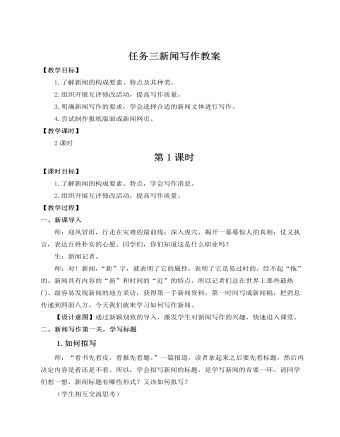
人教部编版语文八年级上册任务三新闻写作教案
五、布置作业新闻是我们了解社会、了解世界的窗口,每天都有各种各样的新闻发生。虽然新闻写作活动已经结束,但是听新闻、看新闻的活动才刚刚启幕。学了新闻写作的方法,我们再去听新闻、看新闻,就更有针对性,更能了解作者的写作意图。今天的作业比较特殊,是一个长期的作业,即希望同学们能够每天坚持至少听新闻、看新闻十分钟。结束语:同学们,明代思想家顾宪成有名联:“风声雨声读书声声声入耳;家事国事天下事事事关心。”“新闻每天发生,视角各有不同。”网络时代,我们更应该走向更广阔的世界,用一双新闻眼,发现生活中的新闻事件,传播正能量的新闻事实。这是我们的义务,也是我们光荣的责任。【设计意图】写作新闻是提升综合素质的绝佳途径之一,它让我们紧贴时代脉搏,既开阔了视野,又锻炼了思辨能力,还可以学到各种科学新知、流行文化。在学生了解了新闻写作的基本方法后,向他们提出听新闻、看新闻的要求,旨在培养他们关心时事的习惯,为他们的素养提升奠基。






